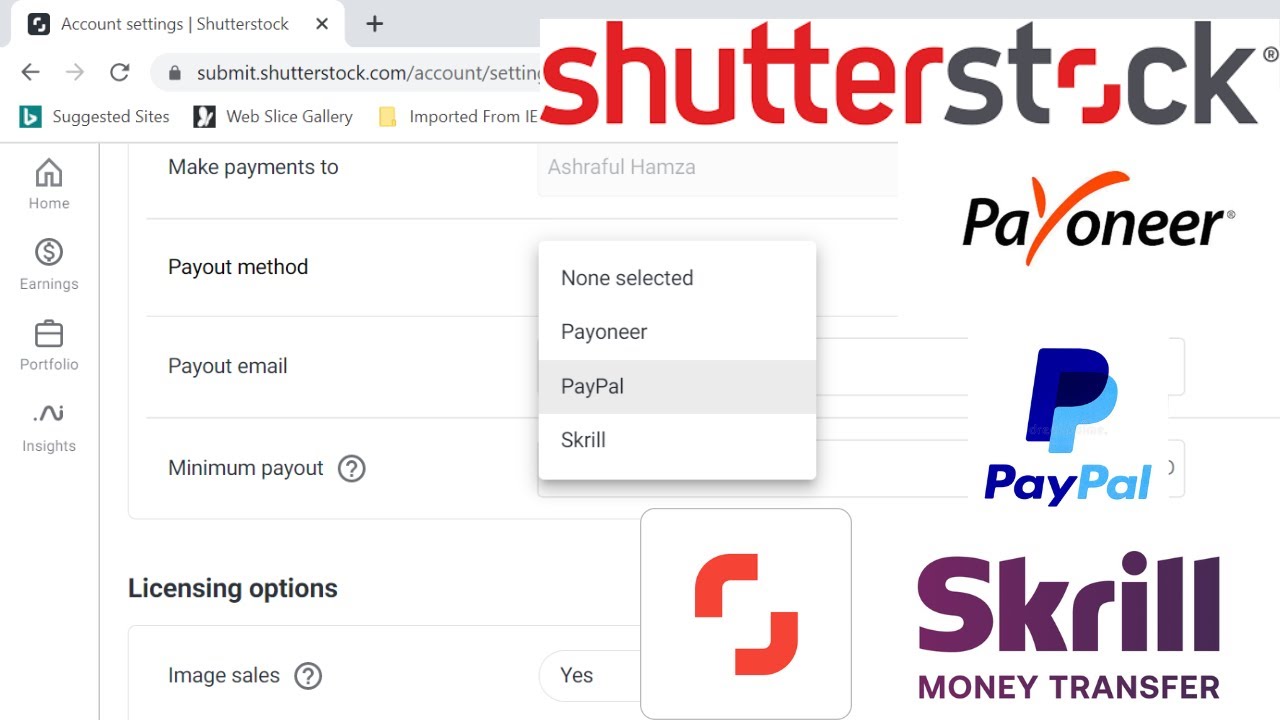Have you ever wondered how photographers and artists earn money through platforms like Shutterstock? It’s one of the biggest stock photo websites out there, connecting creative contributors with millions of users worldwide. But how does Shutterstock make its money, and more importantly, how do contributors get paid? Understanding
How Shutterstock Pays Contributors for Each Image
When you upload an image to Shutterstock, you’re entering into a partnership where your work can generate income every time someone downloads it. But how exactly do you get paid? Shutterstock uses a royalty-based payment system that rewards contributors based on several factors, including your lifetime earnings, the type of license purchased, and your contributor level.
Here’s a quick breakdown of how payments work:
- Royalty Rates: Shutterstock offers different royalty tiers. New contributors typically start with a base rate, which increases as you make more sales and reach higher earning thresholds.
- License Types: Shutterstock offers two main license types – Standard and Enhanced. Standard licenses are more common and cover most uses. Enhanced licenses, which are more expensive, pay higher royalties.
- Download Volume and Earnings Level: The more your images are downloaded, the higher your royalty rate can become. Shutterstock rewards top contributors with increased rates, sometimes up to 30-40% per sale.
- Payment Schedule: Shutterstock pays contributors monthly via PayPal or Payoneer. To receive a payout, you need to meet the minimum earning threshold, typically $35.
In addition to the percentage-based royalties, Shutterstock also offers a contributor dashboard where you can track your sales, see which images perform best, and understand your potential earnings. The platform is designed to be transparent, giving you insights into how each download translates into your income.
So, in a nutshell, Shutterstock pays contributors based on a combination of royalty tiers, license types, and download volume. The more popular your images, the more you can earn — making it a platform that truly rewards creativity and consistency.
Factors That Affect Your Earnings Per Picture
When it comes to earning money on Shutterstock, there’s no one-size-fits-all answer. Your actual earnings per image can vary widely based on several factors. Understanding these can help you optimize your contributions and maximize your income.
First up is your contributor level. Shutterstock has a tiered system that rewards consistent contributors with higher earnings. As you upload more images and generate more sales, you move up the ranks—from Standard to Premium, and eventually to Elite. Higher tiers typically unlock better payment rates, so the more you contribute and sell, the more you can earn per image.
Next, think about the type of license purchased. Shutterstock offers two main licenses:
- Standard License: Suitable for most uses like websites, blogs, or social media. Payment rates for Standard Licenses are generally lower.
- Enhanced License: For more extensive use, such as in print runs over 500,000 copies or merchandise. These licenses tend to generate higher payouts per image.
Then, there’s the image’s popularity and demand. Images that align with trending topics, wide appeal, or high-quality visuals tend to sell more frequently. Moreover, images that fill a niche or are unique are more likely to be purchased repeatedly, increasing your earnings over time.
Another important factor is your keywording and metadata. Properly tagging and describing your images makes them more discoverable. The more potential buyers find your images, the higher the chance of sales—and consequently, the more you earn per picture.
Lastly, geographic factors can play a role. Shutterstock’s payment rates can differ based on the buyer’s location and the licensing agreement in place. Some regions might have different purchasing behaviors, affecting your overall earnings.
In a nutshell, your earnings per image are influenced by your contributor level, license type, image demand, how well you optimize your keywords, and buyer location. By paying attention to these factors, you can actively work to boost your income on Shutterstock.
Average Payment Rates for Shutterstock Contributors
So, what kind of money can you expect to make per image on Shutterstock? While it varies, understanding the average rates can give you a ballpark idea of your potential earnings.
Typically, standard contributors earn between $0.25 to $2.50 per download. The exact amount depends on your contributor level and the type of license purchased. As you advance through Shutterstock’s tiers, your payout per download tends to increase.
For premium contributors or those at the top tier—like Elite contributors—the average earnings per image can reach between $0.50 and $3.00 or more. These contributors often have a large portfolio, high sales volume, and are more strategic with their keywording and image selection.
| Contributor Level | Average Earnings Per Download |
|---|---|
| Standard | $0.25 – $1.00 |
| Premium | $1.00 – $2.50 |
| Elite | $2.00 – $3.00+ |
Keep in mind, these are averages. Some images might sell only once or twice, earning a few dollars, while others—especially popular, high-demand images—can generate numerous downloads, boosting your total income significantly.
Additionally, it’s worth noting that Shutterstock pays out monthly, and your earnings depend on your sales volume and licensing mix. The more you upload and optimize your images, the better your chances of earning higher payouts per image.
In summary, while the average earnings per image vary, understanding these ranges helps set realistic expectations. Consistently contributing high-quality images, optimizing keywords, and targeting trending topics can help you move toward the higher end of these averages and grow your Shutterstock income over time.
Tips to Maximize Your Earnings on Shutterstock
So, you’re eager to boost your earnings on Shutterstock? Great! Earning more isn’t just about uploading as many images as possible—it’s about smart strategies that make your portfolio stand out and attract the right buyers. Here are some practical tips to help you maximize your Shutterstock income:
Focus on High-Demand Topics
Keep an eye on current trends and popular themes. Shutterstock’s marketplace favors images that align with what’s trending, such as remote work setups, sustainability, or health and wellness. Use keyword research tools or browse the top-selling images to identify what’s in demand. Creating relevant, timely content increases the chances of your images being purchased.
Optimize Your Keywords and Titles
Think of keywords as the bridge between your images and potential buyers. Use descriptive, specific keywords that accurately represent your images. Avoid keyword stuffing—be clear and concise. Include relevant tags, but also consider long-tail keywords for niche searches. A well-optimized image can get discovered more easily, leading to more sales.
Create a Diverse Portfolio
Don’t rely on just one type of image. Diversify your portfolio with photos, vectors, and illustrations across various categories. This not only attracts different types of clients but also increases the chances of multiple sales. Keep experimenting and updating your portfolio with fresh content.
Maintain Consistent Quality
High-quality, well-composed images are more likely to sell. Use good lighting, proper cropping, and avoid noise or pixelation. Shutterstock’s review process is strict—images need to meet their standards for resolution and clarity. Consistently uploading quality content builds your reputation and can lead to higher earnings per image.
Participate in Promotions and Creative Contests
Shutterstock occasionally runs promotions or contests that can give your images extra visibility. Participating can lead to increased downloads and exposure. Keep an eye on the platform’s announcements and consider submitting images specifically for themed contests.
Engage with the Shutterstock Contributor Community
Join forums or social media groups where fellow contributors share tips and experiences. Networking can provide valuable insights into what sells best and how to improve your submissions. Plus, staying connected keeps you motivated and inspired to keep creating.
Remember, maximizing your earnings is a game of consistency, quality, and understanding your market. Keep learning, refining your skills, and staying updated with trends. Over time, these efforts can significantly boost your Shutterstock income!
Conclusion and Final Thoughts on Shutterstock Revenue Potential
Wrapping things up, it’s clear that earning on Shutterstock isn’t an overnight success story. The platform offers a fantastic opportunity for photographers, illustrators, and designers to turn their creativity into a steady income stream—but it requires patience, strategy, and persistence.
Understanding how Shutterstock pays per image—whether through royalties, exclusive vs. non-exclusive licensing, or subscription-based earnings—helps you set realistic expectations. While some images might sell frequently, others may only generate occasional income, so diversifying your portfolio is key.
Don’t forget, your earning potential depends on several factors:
- Quality of your images – sharper, well-composed images sell better.
- Relevance and trends – aligning your content with current market demands boosts sales.
- Keyword optimization – making your images easy to find is crucial.
- Consistency – regularly uploading new content keeps your portfolio active and visible.
While the income might start slow, many contributors find that with dedication, their earnings can grow substantially over time. The key is to stay motivated, keep improving your craft, and adapt to market changes. Whether you’re looking for a side hustle or a full-time income, Shutterstock can be a valuable platform if you approach it thoughtfully.
So, keep creating, stay patient, and enjoy the journey of turning your passion into profit. Who knows? With persistence, you might just unlock your full earning potential on Shutterstock!



